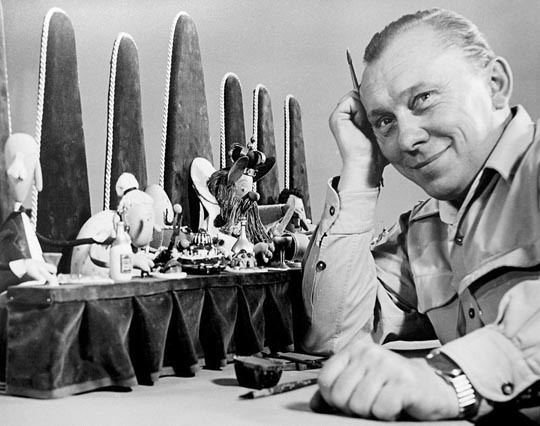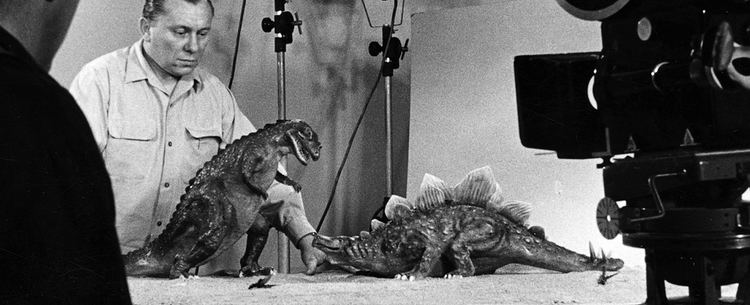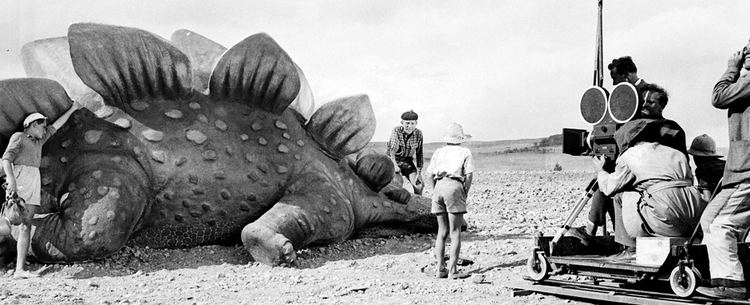Name Karel Zeman | ||
 | ||
Died April 5, 1989, Zlin, Czech Republic Spouse Ludmila Zemanova (m. ?–1989) Children Ludmila Zeman, Karel Zeman Awards Cannes Jury Prize - Short Film Movies The Fabulous World of J, Journey to the Beginnin, The Fabulous Baron Mu, Two Years' Vacation, Krabat – The Sorcerer Similar People | ||
Karel Zeman: The Fabulous Baron Munchausen - TRAILER of the digitally restored film
Karel Zeman (November 3, 1910 – April 5, 1989) was a Czech film director, artist, production designer and animator, best known for directing fantasy films combining live-action footage with animation. Because of his creative use of special effects and animation in his films, he has often been called the "Czech Méliès."
Contents
- Karel Zeman The Fabulous Baron Munchausen TRAILER of the digitally restored film
- movies karel zeman
- Life
- Legacy
- References

movies karel zeman
Life

Zeman was born on November 3, 1910, in Ostroměř (near Nová Paka) in what was then Austria-Hungary. At his parents' insistence, he studied business at high school in Kolín. In the 1920s, he studied at a French advertising school, and worked at an advertising studio in Marseilles until 1936. It was in France that he first worked with animation, filming an ad for soap. He then returned to his home country (by now the First Czechoslovak Republic, known as Czechoslovakia), after visiting Egypt, Yugoslavia, and Greece. Back in Czechoslovakia, Zeman advertised for Czech firms like Baťa and Tatra. In 1939 he attempted to make an extended stay in Casablanca, but was barred by the Protectorate of Bohemia and Moravia established by Nazi Germany; unable to get the necessary papers in time, Zeman was required to remain in his home country during the German occupation of Czechoslovakia.

At Baťa's window-dressing school, where he was teaching, Zeman met the animator Elmar Klos and showed him a sample of his work. Klos offered Zeman a job at Zlín's animation studio. After some consideration (his wife and children were already established in Brno), Zeman accepted the job in 1943. At the studio, Zeman worked as an assistant to the pioneering animator Hermína Týrlová, and in 1945 he became the director of the stop-motion animation production group. The same year, in collaboration with his brother Bořivoj Zeman, he made his first short film, Vánoční sen ("A Christmas Dream"). The short, which combined animated puppets with live-action footage, marked the beginning of Zeman's experiments with new techniques and genres.

Zeman then went on to solo work, including a series of satirical cartoon shorts starring a puppet called Mr. Prokouk; the series was a wide success and the character became a Czech favorite. A bet Zeman accepted, challenging him to discover a method of working with glass in animation, led to the unusual short Inspirace ("Inspiration," 1948), which tells a wordless, poetic love story using animated glass figurines. Zeman then went on to the half-hour film Král Lávra (1950), based on the satirical poem by Karel Havlíček Borovský; the film won a National Award. In 1952, Zeman completed his first feature film, Poklad ptačího ostrova ("The Treasure of Bird Island," 1952). It was based on a Persian fairy tale and took its visual inspiration from Persian paintings, combining multiple animation techniques in two- and three-dimensional space.

It was in 1955, however, that Zeman began the work for which he is most well-known: six feature films designed artistically to combine live-action and animation techniques. These were:
He was a member of the jury at the 2nd Moscow International Film Festival in 1961 and at the 7th Moscow International Film Festival in 1971. The Czechoslovakian government awarded him the title of National Artist in 1970.
After his live-action films, Zeman experimented with more classical forms of animation, beginning with seven shorts about Sinbad the Sailor which were then expanded into the feature film Pohádky tisíce a jedné noci (1974). His final films were Čarodějův učeň (1977), from the novel The Satanic Mill by Otfried Preußler, and Pohádka o Honzíkovi a Mařence (1980). On November 3, 1980, in celebration of Zeman's seventieth birthday, President Gustáv Husák awarded him the Order of the Republic.
Zeman died in Gottwaldov (present-day Zlín) on April 5, 1989, a few months before the Velvet Revolution.
Legacy
Zeman's works were influential to the Czech animator Jan Švankmajer, as well as to the American filmmaker Terry Gilliam, who said of Zeman: "He did what I'm still trying to do, which is to try and combine live action with animation. His Doré-esque backgrounds were wonderful." The American filmmaker Tim Burton described Zeman's creative process as "extremely inspirational" to his own work, and identified Zeman and the American animator Ray Harryhausen as his influences "in terms of doing stop motion and a more handmade quality … Karel Zeman did that amazingly." Harryhausen himself also spoke in interviews of his admiration for Zeman, and the films of the American director Wes Anderson have included homages to Zeman's works.
The film historian Georges Sadoul identified Zeman as having "widened the horizons of the eighth art, animation," adding:
He is justly considered Méliès's successor. He undoubtedly brings the old master to mind, not only because he is an artisan impassioned by art, creating his "innocent inventions" with infinite patience rather than with large budgets, but also because of his ingenuous and always ingenious fantasies. Less intellectual than Trnka, but nonetheless his equal, he has great zest and a marvelous sense of baroque oddities and poetic gags.
On the occasion of an animation exhibition in 2010, curators at the Barbican Centre said of Zeman: "although his influence outweighs his global fame, he is unarguably one of the greatest animators of all time."
In 2012 a museum dedicated to Zeman and his work, the Muzeum Karla Zemana, opened near the Charles Bridge in Prague.
